Vahana of Hindu Diety

Stone Buddha Statue For Positive Energy
September 5, 2018
Indian and Italian Marble Available In India
September 21, 2018Vahana denotes the being, typically an animal or mythical entity, a particular Hindu deity is said to use as a vehicle. In this capacity, the vahana is often called
the deity’s “mount”. Upon the partnership between the deity and his vahana is woven much iconography and mythology. Deities are often depicted riding (or simply
mounted upon) the vahana. Other times, the vahana is depicted at the deity’s side or symbolically represented as a divine attribute. The vahana may be considered an
accoutrement of the deity, though the vahana may act independently, they are still functionally emblematic or even syntagmatic of their “rider”. The deity may be seen
sitting or standing on the vahana.
GANESHA
While the god Ganesha was still a child, a giant mouse began to terrorize all his friends. Ganesha trapped him with his lasso and made him his mount. Mushika was
originally a gandharva, or celestial musician. After absent mindedly walking over the feet of a rishi (sage) named Vamadeva, Mushika was cursed and transformed
into a mouse. However, after the rishi recovered his temper, he promised Mushika that one day, the gods themselves would bow down before him. The prophecy was
fulfilled when the mouse became the vahana of Ganesha.
 |
| RM Ganesha Statue |
CHMUNDA MAA
SHIVA (MAHADEV)
Before becoming the vehicle of Shiva, Nandi was a deity called Nandikeshvara, lord of joy and master of music and dance. Then, without warning, his name and his
functions were transferred to the aspect of Shiva known as the deity Nataraja. From half-man, half-bull, he became simply a bull. Since that time, he has watched
over each of Shiva’s temples, always looking towards him.
 |
| Rameshwaram Marble |
KARTIKEYA
Kartikeya, the war-god known as Murugan in Southern India, is also mounted on a peacock. This peacock was originally a demon called Surapadma, while the rooster
was called the angel[Krichi]. After provoking Murugan in combat, the demon repented at the moment his lance descended upon him. He took the form of a tree and began
to pray. The tree was cut in two. From one half, Murugan pulled a rooster, which he made his emblem, and from the other, a peacock, which he made his mount. In
another version, Karthikeya was born to kill the demon, Tarakasura. He was raised by the Krittikas and led the divine armies when he was 6 days old. It is said that
after defeating Tarakasura, the god forgave him and transformed him into his ride, the peacock.
SARASWATI
Saraswati is the Hindu goddess of knowledge, music, art, wisdom and learning worshipped throughout India. Saraswati is also worshipped outside the Indian subcontinent,
in nations such as Japan, Vietnam, Indonesia and Myanmar. The goddess Saraswati is often depicted as a beautiful woman dressed in pure white, often seated on a white
lotus, which symbolizes light, knowledge and truth.She not only embodies knowledge but also the experience of the highest reality. Her iconography is typically in white
themes from dress to flowers to swan – the colour symbolizing Sattwa Guna or purity, discrimination for true knowledge, insight and wisdom.
VISHNU
Vishnu is one of the principal deities of Hinduism, and the Supreme Being in its Vaishnavism tradition. Vishnu is the “preserver” in the Hindu trinity (Trimurti)
that includes Brahma and Shiva. In Hindu iconography, Vishnu is usually depicted as having a dark, or pale blue complexion and having four arms. He holds a padma
(lotus flower) in his lower left hand, Kaumodaki gada (mace) in his lower right hand, Panchajanya shankha (conch) in his upper left hand and the Sudarshana Chakra
(discus) in his upper right hand. A traditional depiction is Vishnu reclining on the coils of the serpent Shesha, accompanied by his consort Lakshmi, as he “dreams
the universe into reality”.
DURGA
Durga, also identified as Adi Parashakti, Devī, Shakti, Bhavani, Parvati, Amba, Yogmaya and by numerous other names, is a principal and popular form of Hindu Goddess.
She is the warrior goddess, whose mythology centres around combating evils and demonic forces that threaten peace, prosperity and dharma of the good.She is the fierce
form of the protective mother goddess, willing to unleash her anger against wrong, violence for liberation and destruction to empower creation.
Durga is depicted in the Hindu pantheon as a Goddess riding a lion or tiger, with many arms each carrying a weapon. She appears in Indian texts as the wife of god
Shiva, as another form of Parvati or mother goddess.
MOMAI MAA
Goddess Durga is also called Mahamaya and the corruption of mahamaya is momai and also known as ashapura and Dasha Maa. Momai maa vahan is Camel.
MELADI MAA
Meldi maa vahana is goat.
RAMDEV JI











